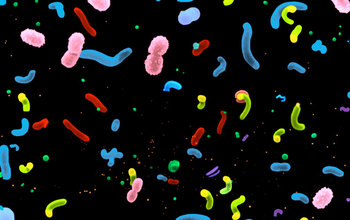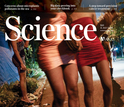Coordinated timing may have implications for ocean food web
 Credit and Larger Version |
Imagine the open ocean as a microbial megacity, teeming with life too small to be seen.
In every drop of water, hundreds of types of bacteria can be found.
Now scientists have discovered that communities of these ocean microbes have their own daily cycles--not unlike the residents of a bustling city who tend to wake up, commute, work and eat at the same times.
Light-loving photoautotrophs--bacteria that need solar energy to help them photosynthesize food from inorganic substances--have been known to sun themselves on a regular schedule.
But in new research results published in this week's issue of the journal Science, researchers working at Station ALOHA, a deep ocean study site 100 kilometers north of Oahu, Hawaii, observed species of bacteria turning on cycling genes at slightly different times.
The switches suggest a wave of activity that passes through the microbial community.
"I like to say that they are singing in harmony," said Edward DeLong, a biological oceanographer at the University of Hawaii at Manoa and an author of this week's paper.
"For any given species, the gene transcripts for specific metabolic pathways turn on at the same time each day."
The observations were made possible by advanced microbial community RNA sequencing techniques, which allow for whole-genome profiling of multiple species at once.
DeLong and colleagues deployed a free-drifting robotic Environmental Sample Processor (ESP) as part of a National Science Foundation (NSF) Center for Microbial Oceanography: Research and Education (C-MORE) research expedition to Station ALOHA.
Riding the same ocean currents as the microbes it follows, the ESP is equipped to harvest the samples needed for this high-frequency, time-resolved analysis of microbial community dynamics.
What the scientists saw was intriguing: different species of bacteria expressing different types of genes in varying, but consistent, cycles--turning on, for example, restorative genes needed to rebuild solar-collecting powers at night, then ramping up with different gene activity to build new proteins during the day.
"It was almost like a shift of hourly workers punching in and out on a clock," DeLong said.
"This research is a major advance in understanding microbial communities through studies of gene expression in a dynamic environment," said Matt Kane, a program director in NSF's Directorate for Biological Sciences, which co-funds C-MORE with NSF's Directorate for Geosciences.
"It was accomplished by combining new instrumentation for remote sampling with state-of-the-art molecular biological techniques."
The coordinated timing of gene firing across different species of ocean microbes could have important implications for energy transformation in the sea.
"For decades, microbiologists have suspected that marine bacteria were actively responding to day-night cycles," said Mike Sieracki, a program director in NSF's Directorate for Geosciences.
"These researchers have shown that ocean bacteria are indeed very active and likely are synchronized with the sun."
The mechanisms that regulate this periodicity remain to be determined.
Can you set your watch by them?
DeLong said that you can, but it matters whether you're tracking the bacteria in the lab or at sea.
For example, maximum light levels at Station ALOHA are different than light conditions in experimental settings in the laboratory, which may have an effect on microbes' activity and daily cycles.
"That's part of why it's so important to conduct this research in the open ocean environment," said DeLong.
"There are some fundamental laws to be learned about how organisms interact to make the system work better as a whole and to be more efficient."
Co-authors of the paper are Elizabeth Ottesen, Curtis Young, Scott Gifford, John Eppley, Roman Marin III, Stephan Schuster and Christopher Scholin.
The research also was funded by the Gordon and Betty Moore Foundation.
-NSF-
Media Contacts Cheryl Dybas, NSF, (703) 292-7734, cdybas@nsf.gov
Talia Ogliore, University of Hawaii at Manoa, (808) 956-4531, togliore@hawaii.edu
Talia Ogliore, University of Hawaii at Manoa, (808) 956-4531, togliore@hawaii.edu
Related WebsitesNSF Grant: Center for Microbial Oceanography: Research and Education (C-MORE): http://www.nsf.gov/awardsearch/showAward?AWD_ID=0424599&HistoricalAwards=false
C-MORE:
C-MORE:
The National Science Foundation (NSF) is an independent federal agency that supports fundamental research and education across all fields of science and engineering. In fiscal year (FY) 2014, its budget is $7.2 billion. NSF funds reach all 50 states through grants to nearly 2,000 colleges, universities and other institutions. Each year, NSF receives about 50,000 competitive requests for funding, and makes about 11,500 new funding awards. NSF also awards about $593 million in professional and service contracts yearly.
Useful NSF Web Sites:
NSF Home Page:
NSF Home Page:
http://www.nsf.gov
NSF News:
NSF News:
http://www.nsf.gov/news/
For the News Media:
For the News Media:
http://www.nsf.gov/news/newsroom.jsp
Science and Engineering Statistics:
Science and Engineering Statistics:
http://www.nsf.gov/statistics/
Awards Searches:
Awards Searches:

Deployment of the Environmental Sample Processor (ESP) for free-drifting plankton sampling.
Credit and Larger Version

Sketch of the Environmental Sample Processor (ESP), suspended from a floatation buoy.
Credit and Larger Version

Research vessel Kilo Moana, from which the Environmental Sample Processor (ESP) was deployed.
Credit and Larger Version

Floatation buoy from which the Environmental Sample Processor (ESP) is suspended.
Credit and Larger Version

The researchers' results are described in the July 11, 2014, issue of Science magazine.
Credit and Larger Version
The National Science Foundation (NSF)
Guillermo Gonzalo Sánchez Achutegui

No hay comentarios:
Publicar un comentario